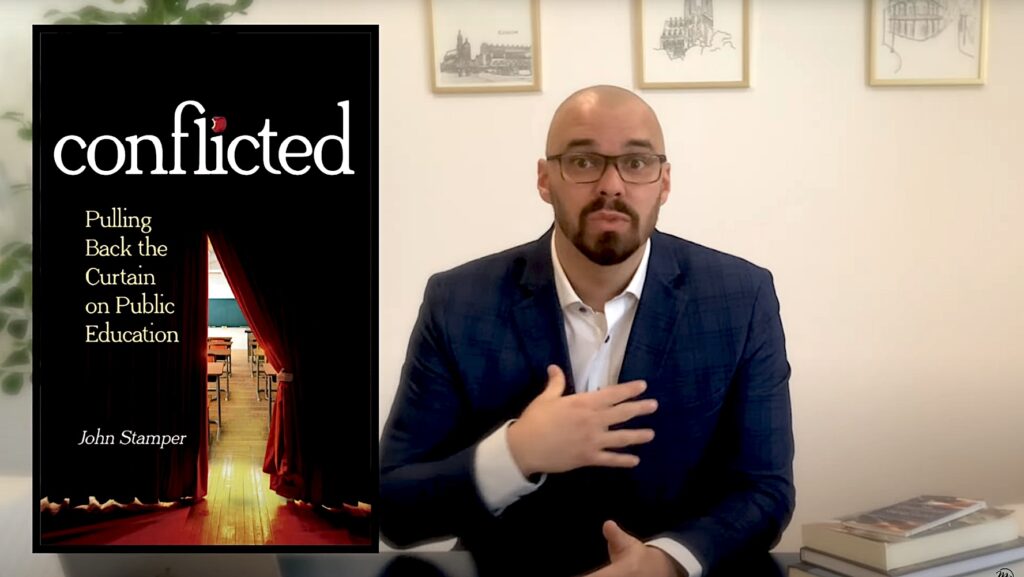‘Conflicted’ explains how radical staff trainings led a schoolteacher to leave public education, warns parents of Nazi-like tactics
Changing school curriculum, replacing textbooks and teachers, and undermining the family unit – what sounds like common public-school criticisms today – enabled the rise of Nazism, warns one…

Changing school curriculum, replacing textbooks and teachers, and undermining the family unit – what sounds like common public-school criticisms today – enabled the rise of Nazism, warns one former schoolteacher.
“There are chilling similarities between how the ideology of the Nazi educational system and the current American public school system were incorporated,” writes John Stamper in his book, Conflicted: Pulling Back the Curtain on Public Education.
Stamper toured Auschwitz in 2019 and described it as “one of the most impactful experiences of my life.”
He describes seeing gas chambers, a mountain of shoes collected from the victims, and an encased room of human hair shaved from the prisoners’ heads.
“How could something like that ever begin in the first place?” he asks, before answering: “The education system played a major role.
“Hitler’s indoctrination process was so successful that in less than a decade of his reign, scores of German children were taken from their parents to form the Hitler Youth, serve as Nazi soldiers, and eventually carry out the horrors of the Holocaust during WWII.”
‘Radical ideologies’
Stamper, who spent 13 years teaching in public and private schools, wrote his book to warn parents “how mandatory teacher trainings are used to implement radical ideologies in schools.”
He worked in Chicago Public Schools for one year as a P.E. coach to K-8th grade students, starting in August 2020.
As he began during the COVID-19 pandemic, he expected mandatory trainings to include practical advice on remote instruction.
However, he found himself forced to study materials “openly presenting Marxist theories and other divisive philosophies as factually true.”
“Instead of being provided with the resources I needed to do my job, the school board decided to train all teachers on far left, political ideologies – and I was expected to integrate these theories into my class,” he wrote.
“My job was to teach students how to throw, catch, kick, play sports, and stay fit – not affirm them if they wanted to change genders, act as if their skin color determines their life, apologize for being a man, or for being white.”
Stamper explained how this process took place without parental knowledge because these mandatory teacher trainings were never made public.
“For months and years even, many skeptics around the country said that no schools were teaching CRT and Gender Theory – but they made those claims because it was all hidden and kept only between the staff and students,” he wrote.
Conflict between teaching vs. ‘direct contradiction’ to Christianity
Stamper describes how he struggled to decide whether to stay in his position as a teacher, weighing his desire to teach and coach with the demands placed upon him by the mandatory staff trainings.
“I had prayed for each position I held and thanked God for every opportunity I was given; I did not want to walk away from things God had blessed me with,” he wrote.
“On the other hand, I could not implement the ideologies that my employer was asking me to implement. I could not, in good conscience, teach my students what I felt to be lies, nor could I participate in something that I felt to be in direct contradiction to my Christian faith.”
Stamper shares his own struggles in explaining why Christians may reach different conclusions on whether to leave or stay in public schools.
“Part of me wanted to be like Daniel in the lion’s den, David facing Goliath, and the three Hebrew youth in the fiery furnace,” he wrote. “The other part of me wanted to be like Lot fleeing the city before certain destruction. This is the conflict I believe so many families are going through, particularly Christian families.”
For Stamper, the answer came after he prayerfully decided to file a formal complaint and resign from his job.
“I did receive a response from the Chicago Public School Board concerning my formal complaint,” he wrote. “In their response, I was notified that there would not be an investigation into the matter at this time. Basically, the school board decided not to investigate themselves. Does anyone else see a problem with that?”
Other whistleblowers besides Stamper have come forward to warn parents of the current ideologies in schools.
For example, Caedran Sullivan submitted an op-ed describing the divisive nature of staff trainings in the Shawnee Mission School District (SMSD) in Kansas.
“SMSD is fostering a toxic environment and requiring employees to attend Diversity, Equity & Inclusion (DEI) training and workshops centered around Critical Race Theory, including Black Lives Matter in the Classroom and Social Justice in the Classroom (using teachers’ “white privilege,” “white supremacy” and “de-colonizing our classrooms” propaganda),” she wrote.
Superseding parental rights
Perhaps the most chilling aspect of Stamper’s book lies in the parallels drawn between current instances in U.S. public schools with Nazi Germany’s steps to undermine the family unit.
Some examples he cites include students changing their gender identities, with the schools keeping this from their parents.
“This type of secrecy and allegiance to the state undermines the sanctity of the family unit and ultimately hurts the child who needs his or her parents,” he wrote. “In fact, creating an ideological separation between children and their parents was a tactic used by Nazi Germany when forming the Hitler Youth.”
When Hitler rose to power, the schools encouraged students to report on their own parents if they chose not to support the National Socialism (Nazi) regime.
Stamper quotes from Adolf Hitler’s letter to a friend, which reads in part: “Children have been deliberately taken away from parents who refused to acknowledge their belief in National Socialism. The refusal of parents to allow their children to join the youth organization is regarded as an adequate reason for taking the children away.”
While the U.S. school system is hopefully not there yet, Stamper sees parallels in steps to define abused or neglected children based on the child’s gender identity or sexual orientation.
One example is Elizabeth Guzman, a Virginia delegate who in 2020 drafted a bill saying “mental abuse” included a parent not affirming their child’s transgender identity.
“By connecting ‘mental abuse’ with physical abuse, this bill would pave the way for children being taken from their ‘abusive’ parents just because the parents disagree on transgenderism,” he wrote.
Furthermore, the bill would report parents to Child Protective Services for such a refusal, opening the way for criminal prosecutions.
“It is difficult to read this any way other than an attempt to blackmail parents with custody of their children,” Stamper wrote.
Even if parents cannot homeschool their children, Stamper provides practical suggestions and tips for families who choose to remain in the public system.
For example, they can form parent-teacher groups and show up at school meetings, constantly communicating with their children as well as teachers and administrators.
“Every family is unique and has their own set of unique challenges, but all parents are tasked with training up their children in the way they should go,” Stamper concluded at the end of his book. “Educating children is difficult but it’s an investment worth making and one that can pay eternal dividends.”



